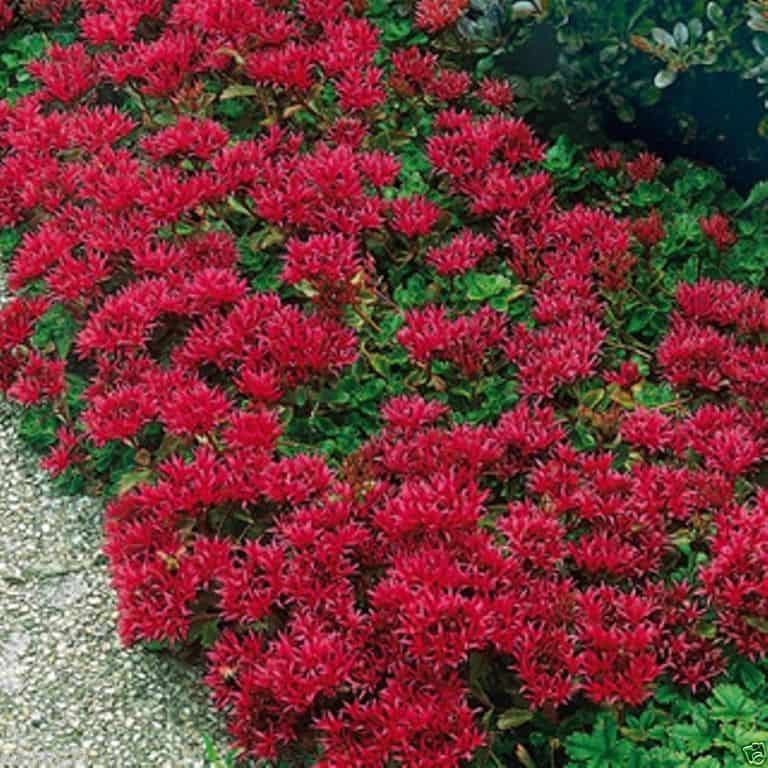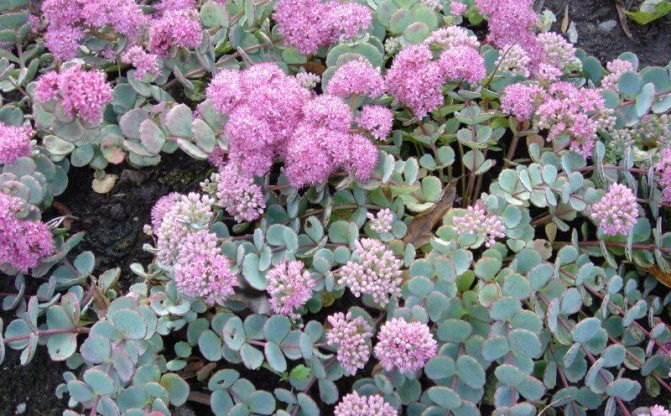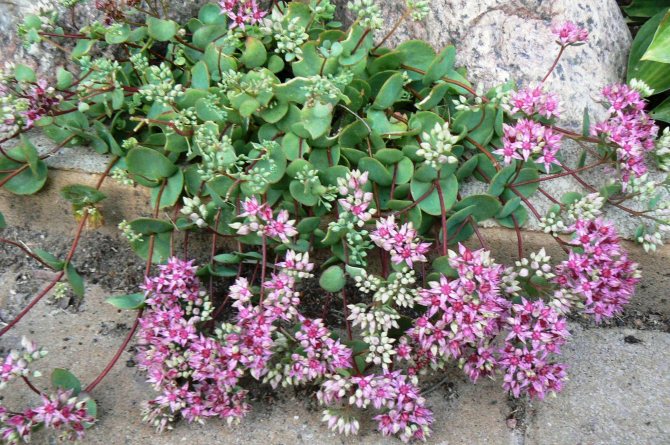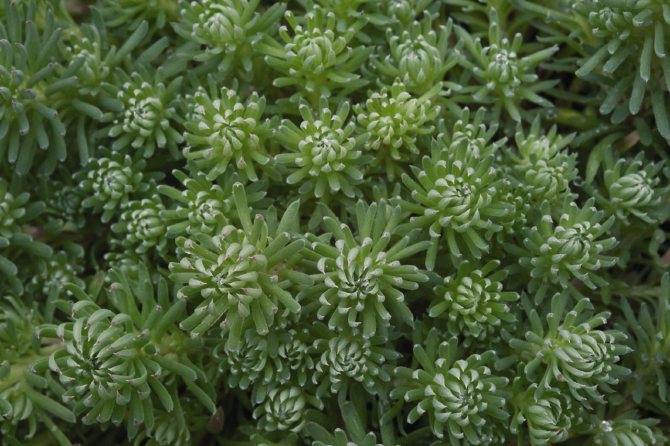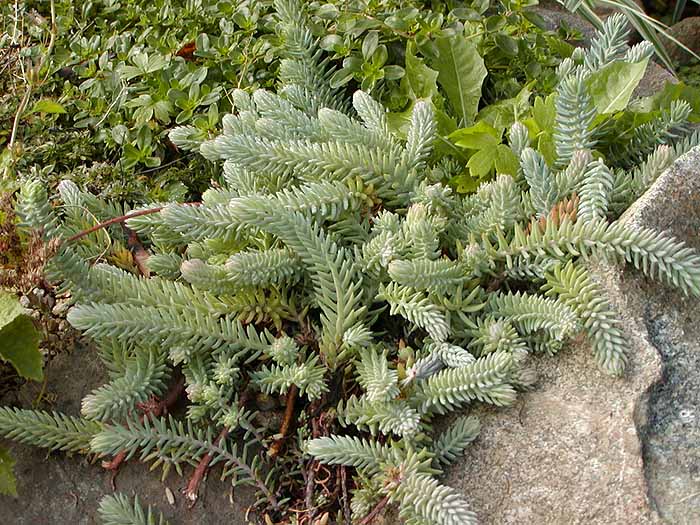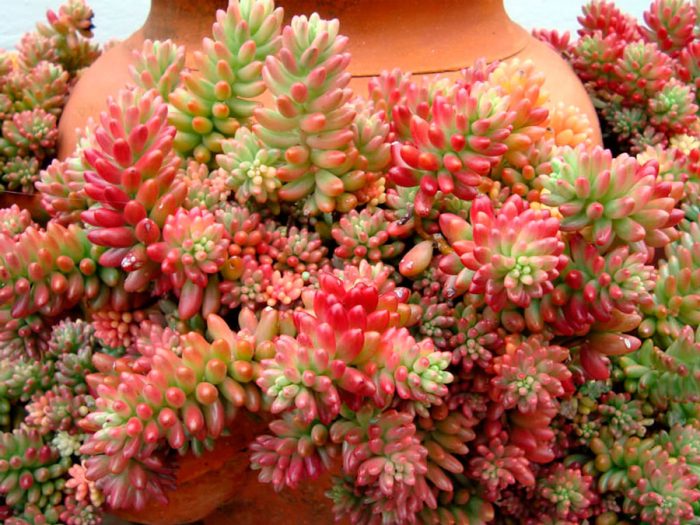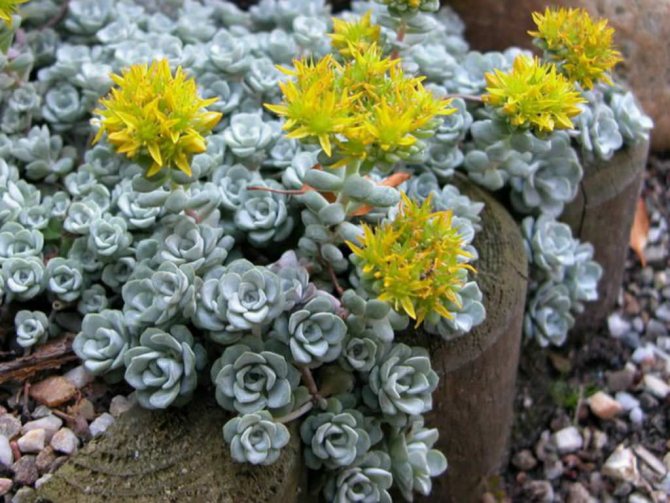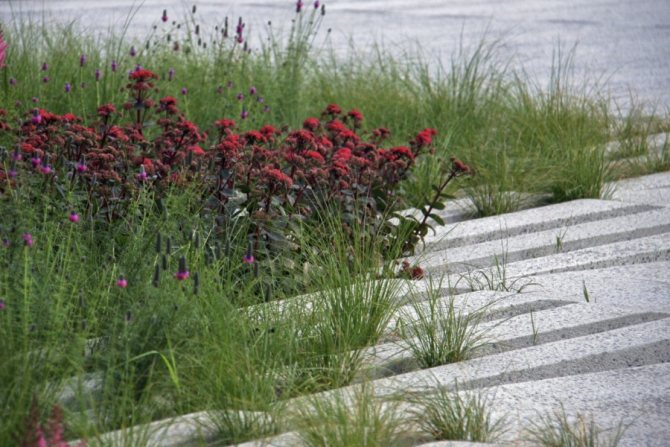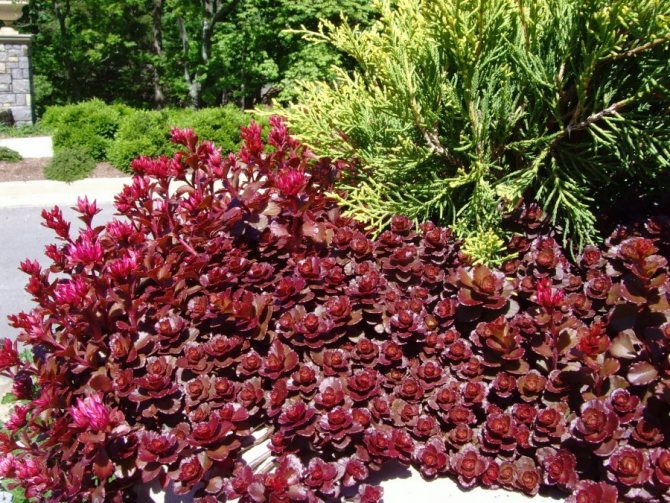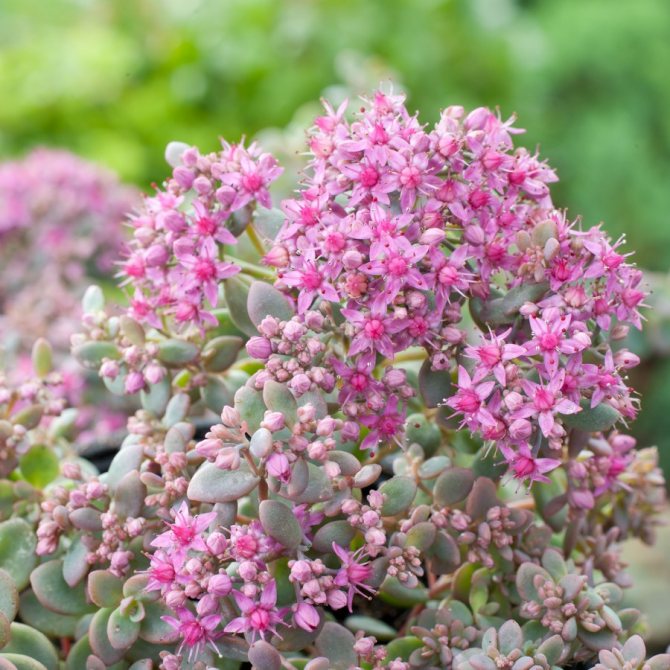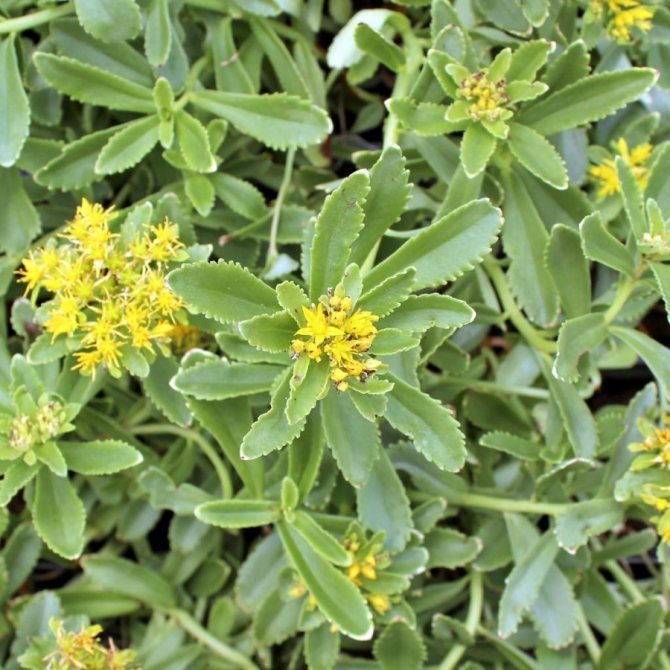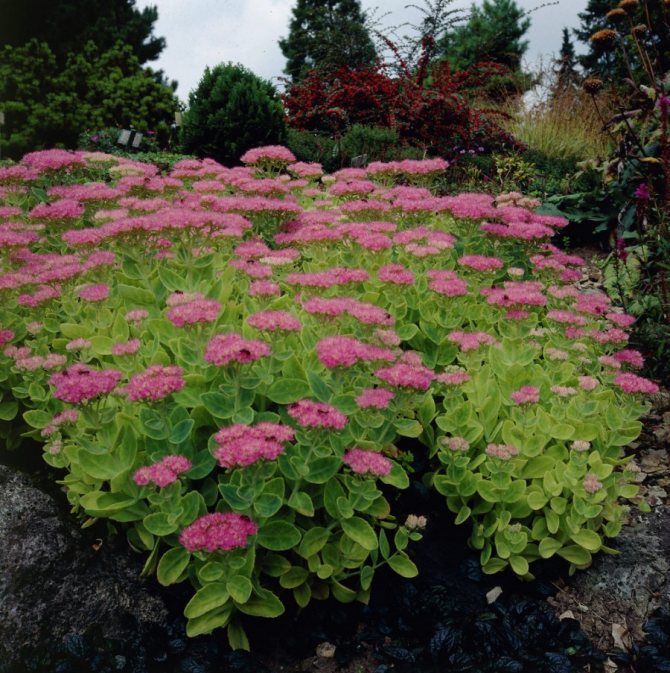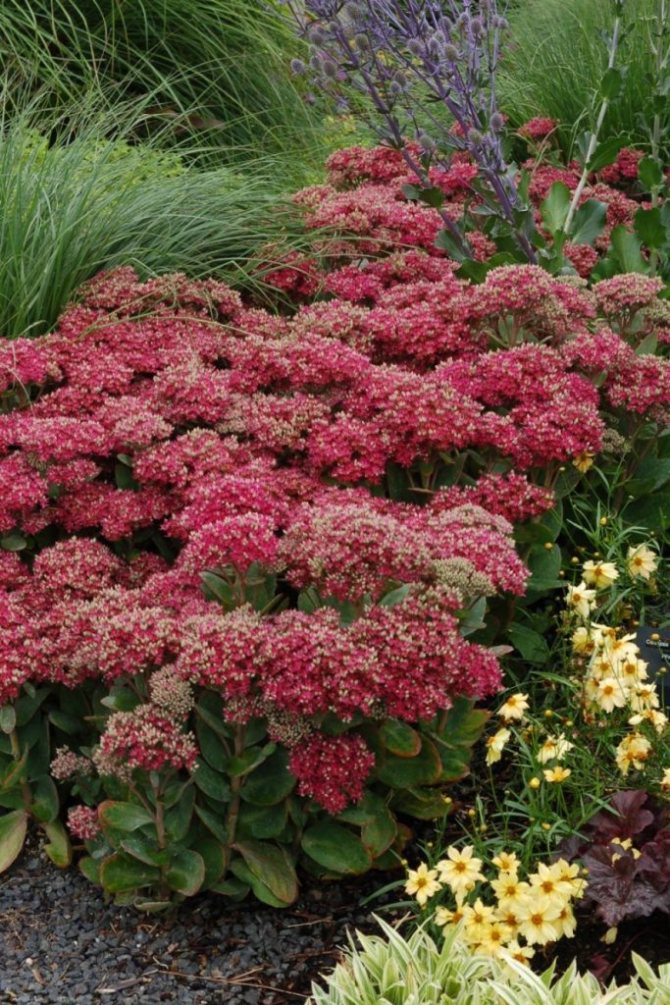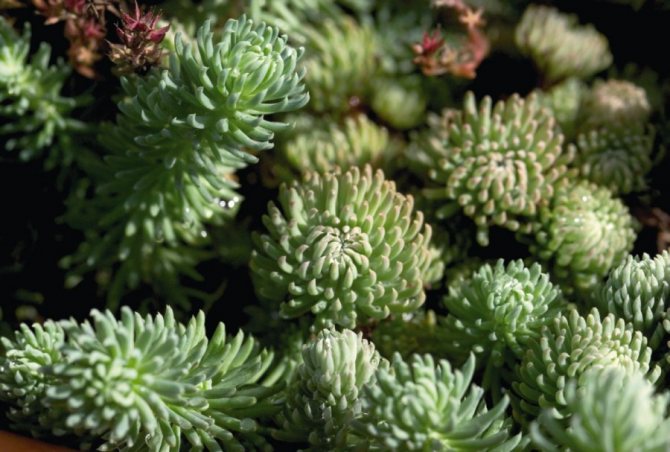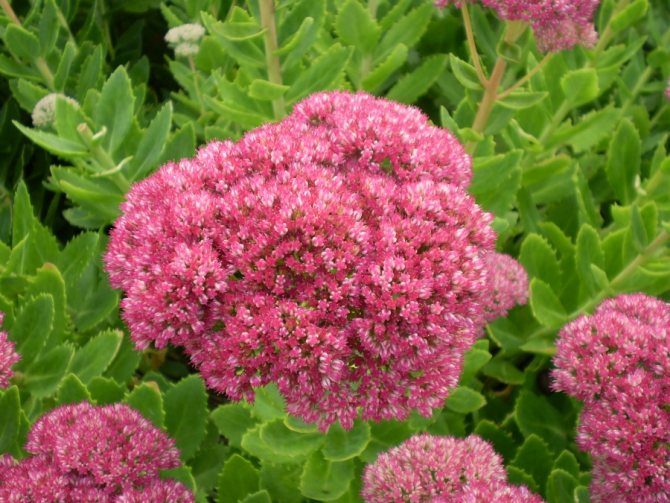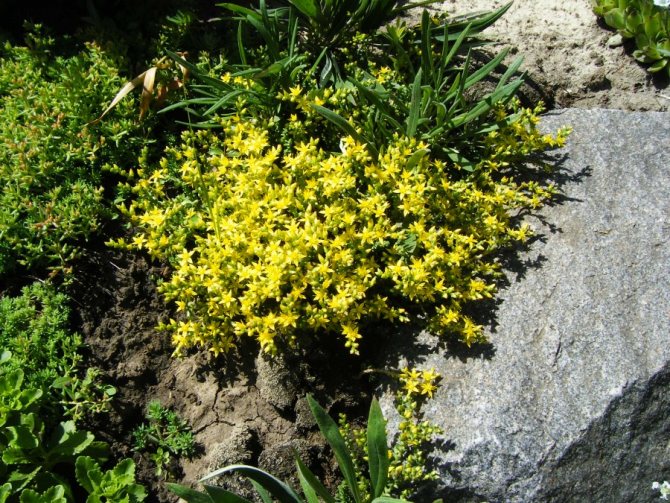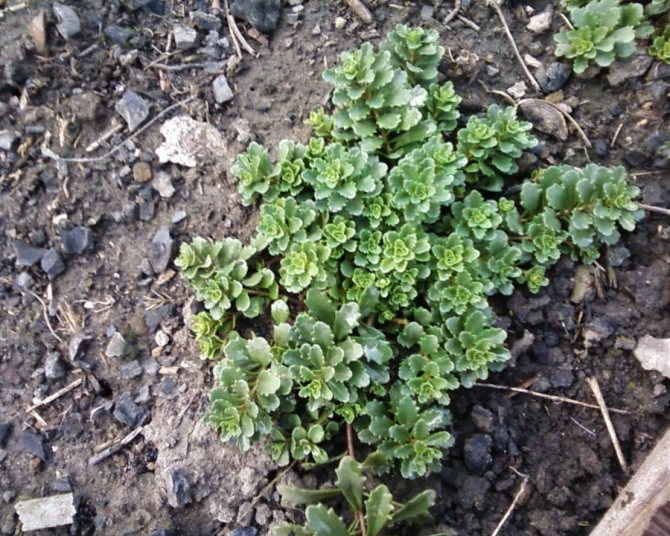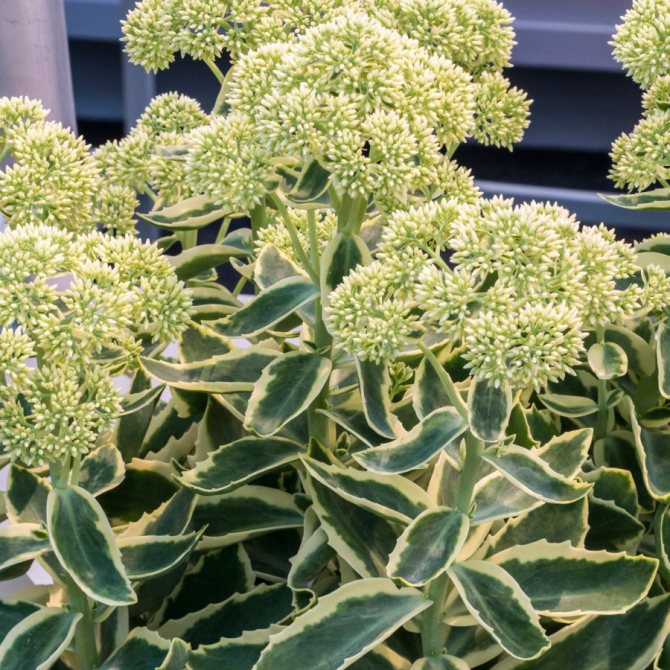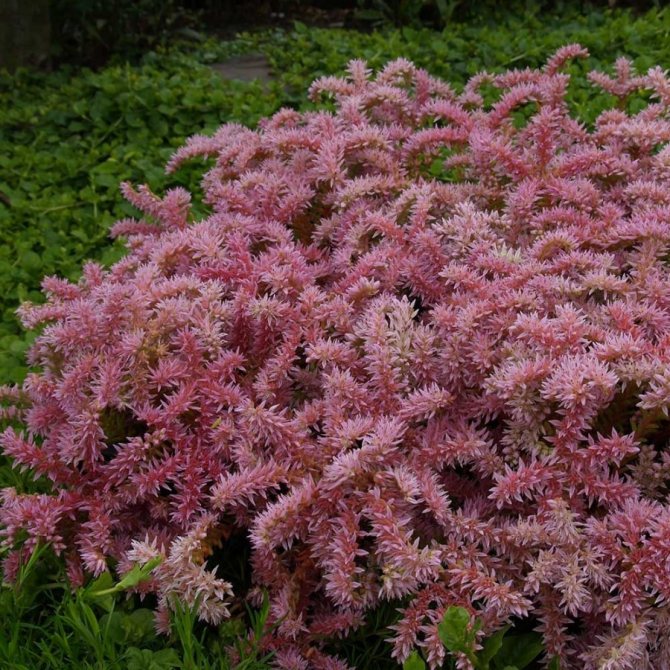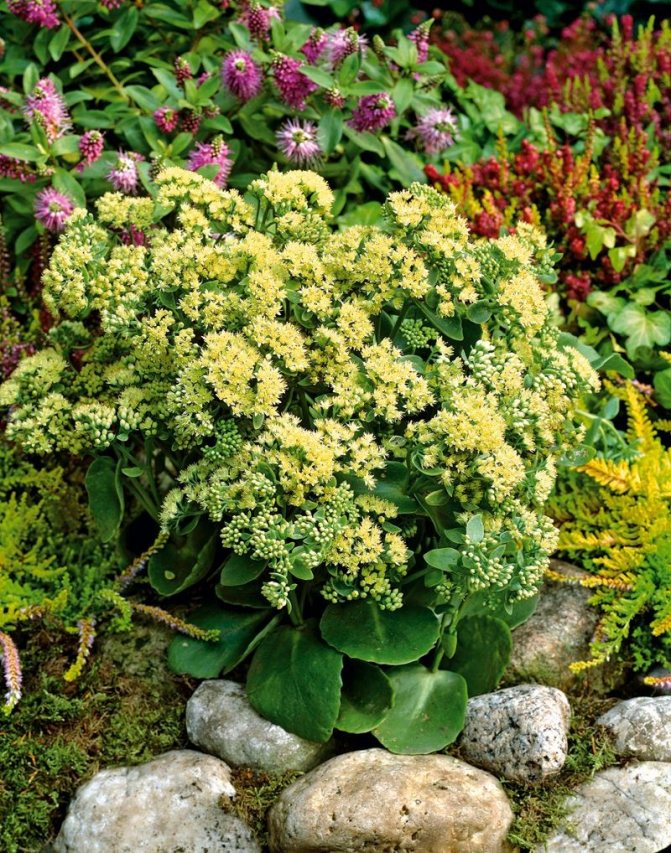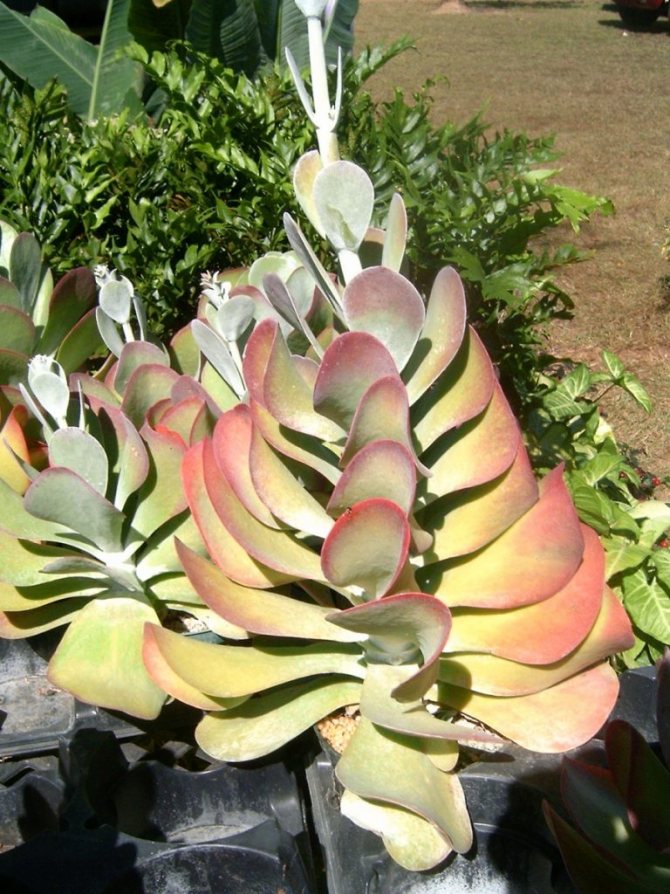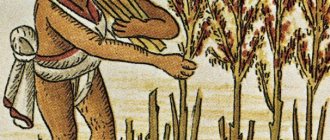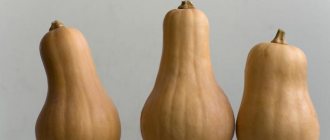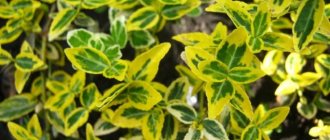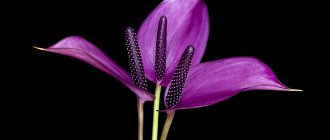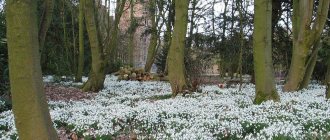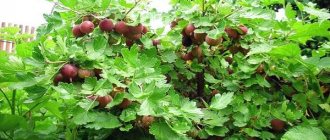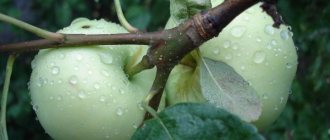Almost all gardeners know about such a flower as Sedum (or sedum). After all, this is the most common ground cover plant, against which other garden flowers stand out perfectly. In indoor floriculture, succulent sedum species also complement flower arrangements and are highly valued for their unpretentiousness. How to choose a sedum variety that can live in indoor conditions and not cause trouble for its owner? We will tell you about this now.
The genus Sedum (lat. Sedum) is quite numerous. It belongs to the Tolstyankov family, in which there are more than 30 genera of plants. Note that sedum (sedum) occupies most of this family and has more than five hundred different species. These are low shrubs, succulents, herbaceous plants. In their natural environment, they can be found in mountainous areas with dry climates in North America, Europe and East Asia. More sedum species have been found in Mexico.
Characteristics of hare cabbage
Hare cabbage has a tuberous root system. The roots of such a plant are quite thick and dense, which makes it much more difficult to pull the bush out of the ground. The plant is characterized by a tall, straight stem that is shaped like a cylinder. The height of the bush can reach 60 cm. Hare cabbage looks like a regular bush.
Usually, hare cabbage has large round or oval leaves. No roughness is observed on their surface. They are completely covered with a thick layer of wax, and there are small teeth on their edges.
Hare cabbage has small flowers. There are inflorescences of pink or yellow shades. They consist of several flowers and are located in the upper part of the plant. Flowers are many-leaved. The flowering of the plant lasts from early July to August. Rabbit cabbage is more common in Europe.
The plant has beneficial medicinal properties.
Types of stonecrops - what are available
The variety is great, hundreds of tropical and cold-resistant species are known. The most decorative of them are cultivated culturally, separated into separate genera (Ochitnik, Zhivuchnik, Petrosedum) and varieties.
Groundcover
These are creeping species that cover the soil, ranging in height from a few to 30 centimeters. The bushes spread out on the ground create the illusion of a dense covering, which makes them seem stunted.
Used to decorate alpine slides, rockeries, curbs, roofs and walls. They are planted in containers (including suspended ones).
Cornflower
Purple flowers of varying intensity, 0.5 centimeters in diameter, are strewn with gray, bluish leaves. There are red blotches on the leaves. The stems are 8-10 centimeters long. The varieties are frost-resistant, demanding for light, moisture and soil looseness. Bloom: August-September. Examples of cultivars: Rosenteppich and Rose Carpet.
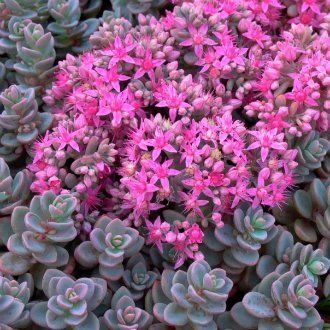
Siebold's sedum
Creeping stems, up to 25 centimeters long. It blooms with multi-colored flowers in October. It is grown in containers, on alpine slides, rockeries. Used to create topiary. Dragon, Mediovariegatum are the most common varieties.


Anacampseros
Easily rooting stems spread and reach a length of 15-20 centimeters. Flowers 0.7 centimeters in diameter, varying in intensity of pink and red, appear in July-August.Bluish-gray leaves are decorative. Demanding on the composition of the soil (does not like alkalization), needs constant weeding and abundant watering.


Kamchatka
The variety Variegatum is widespread. The shoots do not completely lodge, the rhizome becomes woody. Stems of 15-25 centimeters have yellow flowers with stamens during the flowering period (July-September), then scarlet fruits appear. Loves watering, partial shade.


Forster sedum
The rug is 10 centimeters thick and has peduncles up to 30 centimeters high. The leaves are green, bluish, then turn red. The flowers are yellow, pink. It grows rapidly and takes over the area. Nice in containers. Watering is regular. Purpureum, Elegance are famous varieties.
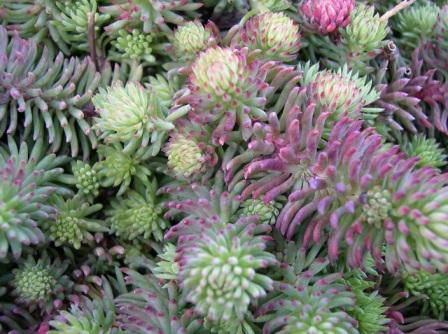

Divergent
Beautiful, very decorative. Bushes up to 5 centimeters high, flower stem 10 centimeters. Green leaves turn red in the sun, flowers are yellow, pink. This is a winter-hardy variety, unpretentious to the soil, does not like excessive watering. They green roofs, plant them in rockeries, decorate topiary.
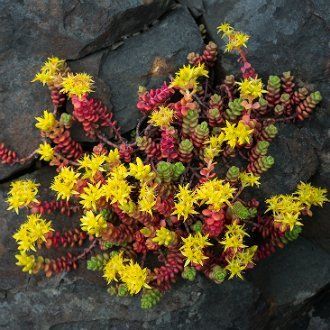

False
Loves the sun, light and partial shade, blooms in July-August. The plant is 15 centimeters high and forms covers on the soil. They decorate flower beds, mixborders, spacious containers. The leaves are green, becoming bronze, red by autumn. Flowers in various shades of pink, burgundy, red and white. Only some varieties: Elizabeth, Tricolor, Album, Leningrad White and others.
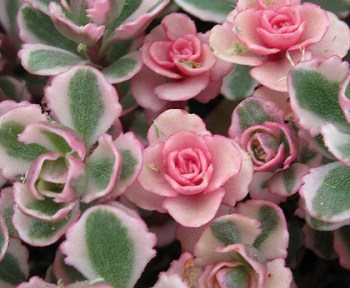

Sedum caustic
The coating is dense, solid, 5-10 centimeters high, poisonous. Green leaves, yellow flowers. Blossoming June-July. Undemanding to the conditions of detention. It tolerates winter and drought well. It is easy to weed out, it grows very quickly. Sedum caustic is a melliferous plant, interesting varieties Minus, Elegance.
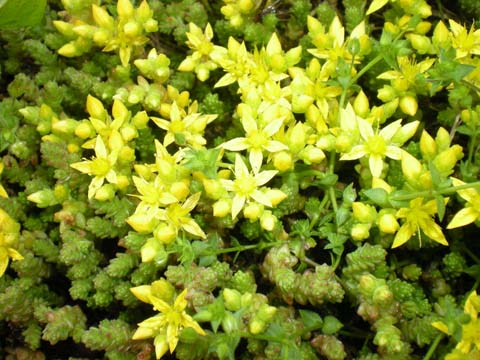

Sedum Evers
Bushes up to 40 centimeters, gray-green leaves with pink inflorescences. Grows rapidly, hardy, unpretentious. Suitable for growing in rockeries, rock gardens.
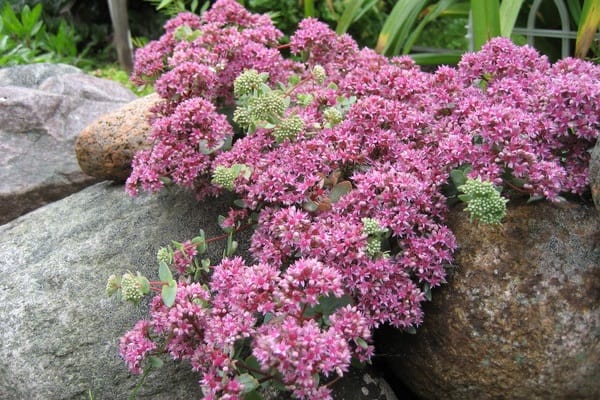

Lydian
A rare variety. Cover 4-5 centimeters. Green leaves turn red in the sun, creeping shoots have white flowers. Does not like drought, grows in partial shade. This evergreen plant will decorate borders and rockeries.
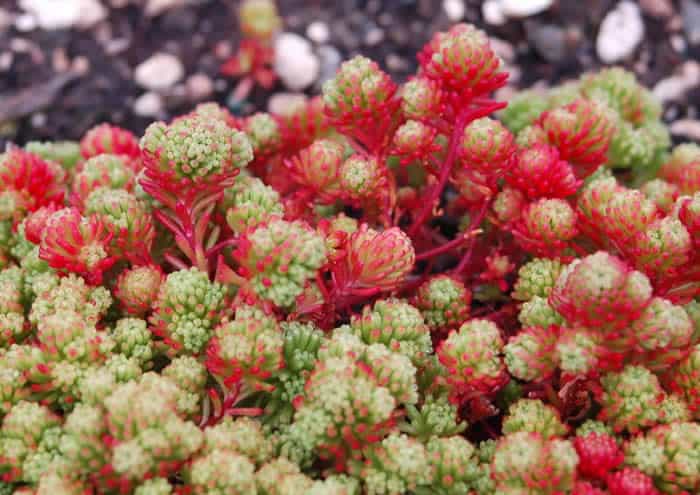

Shrubs
This is a tall species of stonecrop. Such a sedum is unpretentious in cultivation: it grows on soil poor in humus, on rocky areas. High varieties of sedum plants need more watering than creeping ones, because their root system is not covered with a continuous carpet of vegetation.
They bloom from summer to autumn, for many years in one place, they are more popular among gardeners than their undersized counterparts.
Prominent sedum
Forms a bush of 40-70 centimeters. The leaves are green, can be purple in color with a bluish tinge. Flowers from white, white-pink to deep purple. Blooms in August to October, requires moderate watering. Releases air shoots, which are removed. This variety is grown in a spacious container, mixborders, single flower beds. Varieties - Iceberg, Carmen, Crystal Pink, Stephen Ward.
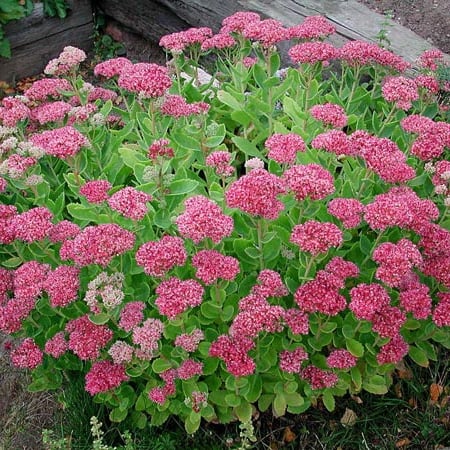

Ordinary
The bush is high, up to 80 centimeters with pink or purple flowers. The leaves are green, oval. July and August are the flowering months. Hare cabbage is grown in mixborder groups, suitable for growing in a container. Bon-Bon, Red Globe, Trafl are common sedum varieties.
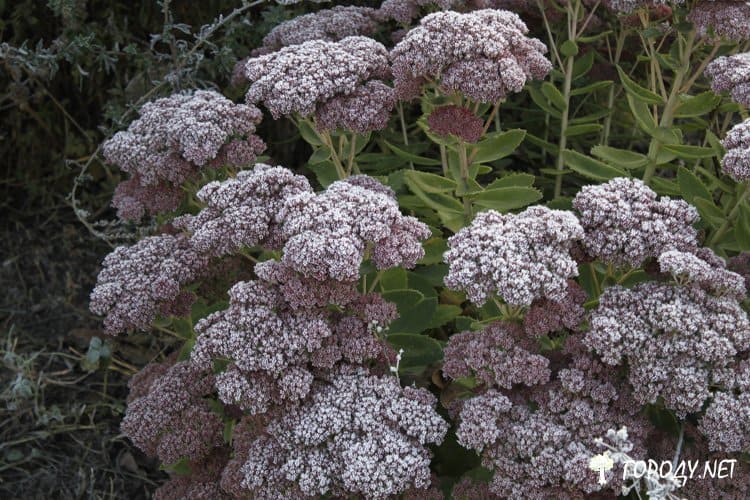

Tenacious
The shrub reaches a height of 50 centimeters. Blooms all summer. Loves shading, prefers scanty soil, unpretentious look. Watering is moderate, regular.


Red dot
This sedum grows up to 60 centimeters in height. Leaves are greenish-gray. Flowers of different colors: white, pinkish, pink. Late blooming in September-October. He prefers sunny places along with partial shade. Watering is moderate.


Varieties of cabbage
There are several types of sour cherry (another name for cabbage).
- Violet oxalis is characterized by a pleasant lilac color.The tree grows up to 1 m in height. This garden culture is often grown at home. Caring for him is timely watering (1 time per week).
- Forest oxalis has characteristics of similarity with another variety - ordinary stonecrop. The difference between them is that the forest variety can only grow in the wild (hence the name). The flower of this species is not very large.
- The red variety is more common in Siberia. The height of the bush reaches 60 cm. Flowers are presented in red or pink colors.
- Common sedum is a houseplant that can be grown at home. The best growth is observed in the wild. The height of the bush is about 70 cm. The flowers have a purple hue.
Description of the plant
Sedum is a low-growing herbaceous succulent plant. All types of stonecrops can be roughly divided into two groups. The first includes thermophilic species that, in our climate, are grown indoors as perennials or as annual crops in the open field. The second group includes frost-resistant ground cover perennial species of stonecrops. In Russia, in natural conditions, they grow mainly in the Caucasus.
Stonecrops have rather branched stems and, when growing, form a lush shrub or semi-shrub.
Their leaves are very dense. They are sessile, have no petioles, and adhere well directly to the fleshy stems. The leaf plates, fleshy, whole, are arranged alternately. They are opposite or whorled. In addition, the shape of the leaf plate, its color and size vary greatly in different types of sedum. There are specimens with swollen, like cylinders, or with leaves as flat as discs.
The leaf plates are painted not only in traditional green, but also in pink, gray, gray, reddish and others. Moreover, the color of the leaves depends not only on the variety or type of stonecrop. Even the same species may differ in the color of the foliage, if the conditions of its growth are noticeably different. The composition of the soil in the pot also affects the color of the leaves. Overfeeding leads to color fading. Sometimes reddish stains appear on the leaves of stonecrop.
Inflorescences are also different: lateral and apical, in shape - corymbose, umbellate and racemose. Flowers in inflorescences are bisexual, star-shaped, of various colors: red, yellow, snow-white, blue. The petals are very dense, slightly bent. When they grow, they grow together into a narrow tube, from which numerous stamens and an ovary peep out. Stonecrop blooms at any time of the year, depending on the species and variety. Most often in late summer or autumn. This is a melliferous plant. The flowers smell so good that they attract with their aroma not only people, but also numerous pollinating insects: butterflies, bumblebees, bees.
Since in nature sedum often grows on steep rocks and large stones, as if hanging from them, it can also be grown in an apartment as an ampelous plant in hanging pots.
Sedum (sedum) is a relative of such indoor flowers as Kalanchoe, rejuvenated, Echeveria and spotted petals.
Useful properties of rabbit cabbage
Sedum or hare cabbage (these are 2 names of the same plant) is characterized by excellent healing properties for the human body.
A plant such as hare cabbage contains vitamins of group C, tannins, carotene, medicinal salts, various natural acids and flavonoids.
Product use:
- helps to get rid of pain;
- tones the whole body (after illness or overwork);
- allows you to heal wounds as soon as possible;
- excellently helps to stop bleeding;
- thanks to the use of leaves, you can quickly cleanse the skin from various inflammations (pimples or acne);
- helps to get rid of allergies, which manifests itself in the form of skin rashes;
- the use of juice will normalize the work of the heart and central nervous system.
Hare cabbage, thanks to its rich beneficial composition, is used in folk medicine. Tinctures are used to treat diseases of the gastrointestinal tract (duodenal ulcer, ulcers or gastritis), hormonal balance (menstrual irregularities) or respiratory diseases (bronchitis, asthma or pneumonia).
Ointments made from finely chopped leaves are used for topical treatments. They are used in the fight against osteochondrosis, radiculitis, or with various cuts and burns. Bunny cabbage wipes can help normalize the flow of breast milk. This method is especially effective in case of its stagnation. Using a decoction of such a herb allows you to remove toxins and toxins from the body.
Harvesting cabbage
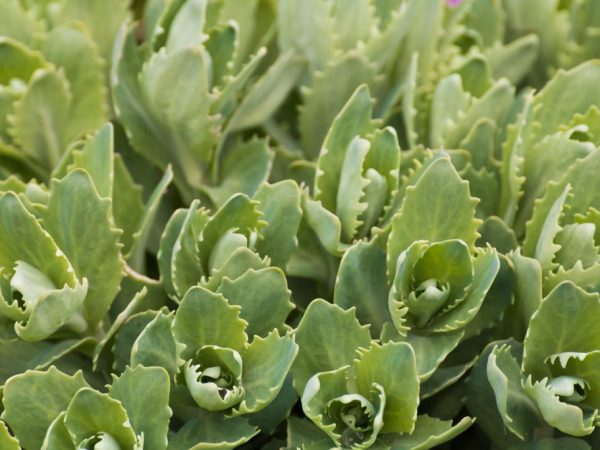

Cabbage is used in folk medicine
In folk medicine, there are recipes that use both the ground part of the culture and the root.
- The grass should be collected and dried at the moment when the bush is just beginning to bloom. It is better to collect flowers and leaves in sunny and dry weather, otherwise there is a risk of reducing the beneficial properties.
- It is better to dig up and collect the roots in early September, when they have absorbed the maximum amount of nutrients from the soil.
The beneficial properties of hare cabbage are maximally manifested only if drying is carried out correctly. It is generally recommended to dry the green part of the plant in large, well ventilated rooms. Before starting to dry the roots, it is important to clear them of the ground and the top layer, cut them into small slices and hang them on the window of a shed or basement.
About the benefits of a flower
Since ancient times, sedum has been considered a healing plant. Its fleshy leaves contain many useful substances: vitamins, tannins, alkaloids, flavanoids, glycosides and others. In alternative medicine, leaves of such types of sedum as "Vidny", "Ordinary" and many others are used. They are used to prepare tinctures on alcohol and water, decoctions, healing extracts. You just need to properly harvest the aerial part of the plant - during flowering. At other times, beneficial nutrients disappear from the plant.
So, sedum "Prominent" used for anemia, epilepsy, diseases of the gastrointestinal tract, ischemia and pulmonary insufficiency. It helps to stop bleeding, relieve inflammation and pain, neutralize the action of microbes and bacteria, discharge phlegm, remove toxins from the body, restore joint mobility, lower blood pressure, calm the nervous system, heal wounds, dilate blood vessels, stimulate the endocrine glands, lower cholesterol strengthening the immune system.
Sedum "Ordinary" differs in anti-inflammatory, stimulating, wound healing, antitumor, regenerating, hemostatic and tonic effect. The extract from its leaves is used as a biostimulant along with aloe. At the same time, the effect on the body is milder and does not cause unwanted side effects.
Sedum "Big" used as an adjunct in the treatment of pneumonia, bronchitis, hepatitis, non-healing wounds and trophic ulcers, for nervous disorders, kidney and bladder diseases, and oncological diseases.
Sedum "Caustic" it has an irritating and diuretic effect. It is used in the treatment of malaria, to enhance intestinal motility, increase blood pressure, heal wounds, burns and ulcers, treat catarrh of the upper respiratory tract, dropsy, anemia, jaundice, and tuberculosis of the skin in children. Means made on the basis of "Caustic" sedum have an analgesic effect.
Infusion of hare cabbage
Rabbit cabbage is often used as a tincture. There are several common recipes.
- About 50 g of chopped leaves should be poured with 500 ml of boiled water. This mixture should be placed in a cool, dark room for 5 hours. After the specified time, the substance is filtered through a sieve or cheesecloth and poured into a clean dish. You need to take the tincture 3 times a day, 30 ml before meals. It is believed that such an infusion is an effective remedy for gastritis, diarrhea, infertility, overwork or kidney failure.
- You need 25 g of the green part of the grass mixed with 25 g of the root system. This mixture must be poured with 500 ml of boiled water and insisted in a thermo-container for 5-6 hours. A similar tincture should be used to lubricate sore spots with sore throat, burns, cuts. Also, such an infusion actively helps to get rid of warts, ulcers or calluses.
How stonecrop multiplies
Reproduction is carried out in several ways: seedlings from seeds, cuttings and dividing the bushes.
Seedlings
In April, sedum seeds can be sown in seedling containers. The seeds are laid out on the surface of the soil (earth and sand), sprinkled with coarse sand and, moistened, covered with glass or film.
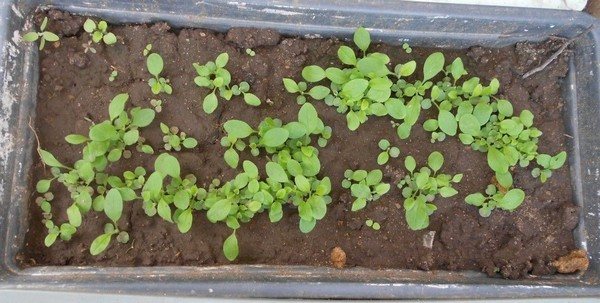

The seedlings are grown in a cool place. From time to time, ventilate and spray the seedlings with a spray bottle. After 2 weeks, the containers are rearranged to a warmer place. Seedlings appear within a month. After the appearance of two leaves, they dive.
Before disembarking on the street, they are tempered for a week, taking out for a certain time.
Propagation by cuttings
Before and after the flowering of the sedum, the plant can be cut and planted. This is a simple procedure, besides, stonecrops take root well. A part of the stem is cut off, deepened into the soil or placed in water (until the roots appear). When roots appear, they are planted in a permanent place.


Dividing the bush
Produced in the spring by digging up and dividing the roots. The presence of kidneys must be checked on each part. The cut is treated with a fungicide and allowed to dry. After a couple of hours, they are planted in place.
Bunny cabbage decoction
Sometimes hare cabbage is used as a decoction. To prepare it, you will need 20 g of dry crushed leaves. They are added to 200 ml of warm water, and the mixture is placed on the stove.
It is necessary to keep the mixture on fire for no more than 10 minutes, otherwise all useful properties will be destroyed by high temperatures. After the specified time, the dishes are removed from the fire and placed in a dark place until they cool completely. After that, it is poured into a clean dish. It should be consumed about 20 ml of the drug, 2-3 times a day. Such a decoction will be effective in the fight against kidney disease.
Possible growing difficulties
- In shady plantings, flowering slows down, the leaves become smaller, the stems are stretched.
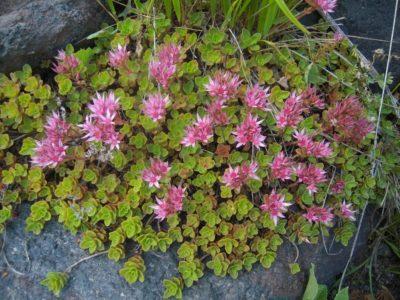

From the dampness of the substrate, fungal infections of the roots and stems appear. Transplantation and replacement of the infected soil cover is required. Drainage and mulching of the top layer with crushed stone is added.- From overdrying the soil, the leaves lose their elasticity, wrinkle.
- The bush has lost its decorative effect, the leaves are deformed - pruning of old stems and rejuvenation of the bush through the rooting of the apical processes are required.
- From an overabundance of fertilizers, the bushes lose their shape, the stems and roots begin to rot. It is necessary to exclude nitrogen fertilizers.
- When caterpillars, thrips, weevils appear on the bushes, it is necessary to treat the bushes with insecticides.
If you are interested in other varieties and types of sedum, then we suggest reading about sedum Blue Pearl, Morgana, Lizard, Matrona, Brilliant, Bent, Purple, Kamchatka, White.
Subject to the temperature regime, moderate watering, timely planting and rejuvenation of the bushes, stonecrop develops rapidly and blooms profusely for a long time.
If you find an error, please select a piece of text and press Ctrl + Enter.
Rabbit cabbage juice
The green part of the cabbage should be thoroughly rinsed under running water and poured with boiling water, insist for 20 minutes.After that, you should make porridge (using a meat grinder or juicer). The resulting juice is mixed with pure water in a 1: 2 ratio.
It is recommended to take 1 tbsp every day. l. juice on an empty stomach, 3-4 times a day. The tool is used for external treatment. If there is a wound or inflammation on the face, then a cotton pad should be moistened with juice and applied to the focus of inflammation or injury.
How to care
Sedum is undemanding to growing conditions, it grows easily, turning the allotted area into a green meadow. He prefers loose, fertile, sandy loam, and acidic lands.
It grows better in light areas, does not bloom in the shade. It accumulates moisture and does not tolerate drought.
Outdoor planting, watering and weeding
Seedlings are planted at the end of May, June, after return frosts (all summer). It is good to add ash and sand to the soil. The site is chosen open, not under the trees. Holes are dug at a distance of 20 centimeters. Sedum will bloom in a year or two.
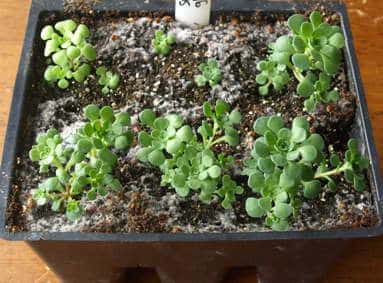

Sedum need periodic watering and weeding, oppressed by the neighborhood with weeds.
Top dressing
Feed with diluted mullein or complex fertilizer. Do not apply fresh manure.
Pruning
Bushes are formed in varietal sedum plants: green shoots are removed on multi-colored varieties so that the breed does not degenerate. Overgrown stems, dry inflorescences are also cut off, giving a compact planting.
Sedum in winter
In regions where there is abundant snow, sedum is not covered for the winter. Preparation for wintering includes pruning of almost all shoots. The remaining stems are sprinkled with earth. Pruned shoots can be rooted, stored at home and planted in the soil in the spring.
Transplant and rejuvenation
Sedum thickets are aging and need transplantation and rejuvenation. In spring or autumn, old twigs are removed, young plantings are divided into parts and transplanted to another place. It is enough to carry out this procedure once every 3-4 years.
Rabbit cabbage flower
A decoction made from the flowers of this plant perfectly helps to cope with the general fatigue of the body and increases the tone of the whole body. It is an effective remedy for improving the immune system. The broth should be consumed 3 times a day, 30 ml each. It is best to do this with meals.
Fresh flowers are edible, quite tasty. They help to restore the body after a long and difficult illness. It has an analgesic and healing effect when applied to a wound or burn.
Contraindications
Only the "Caustic" stonecrop has contraindications, because its juice has an irritating effect. Preparations made from this type of plant should not be used for hypertensive patients, patients with nervous excitability, children under 18 years of age and pregnant women. When used externally, there may be burning, irritation or redness of the skin, and if its juice is taken internally, it can cause nausea. In this regard, before using preparations made from the "Caustic" stonecrop for treatment, consult your doctor. Otherwise, it is better to abandon the application altogether.
Transfer
Young oxalis needs to be replanted annually, and an adult plant every 2-3 years. A transplant is required if the plant:
- has grown greatly;
- has adapted to new conditions after the acquisition;
- sick.
You need to transplant carefully, using the transshipment method, so as not to damage the fragile roots.
Transplant instructions
- prepare the soil and a new container for the flower;
- pour drainage on the bottom of the flowerpot or pots and fill in the soil;
- water the oxalis well, and then remove it from the old pot;
- place the plant in a new container;
- deepen the root by a maximum of 2 cm, since the oxalis does not like deep planting.
Stonecrop care at home: how to get rid of pests
Plants of the genus stonecrop are rarely attacked by pests and diseases. Almost all domesticated species do not give their owner much difficulty in caring for themselves.
In the description of the ornamental plant sedum, it is said that broad-leaved species, such as stonecrop, can be affected by the caterpillars of true sawflies from the family Tenthredinidae in late June or early August.
As soon as pests have been found, the plant should be treated with Aktelik. You can also bait the pests with nearby cabbage or lettuce leaves and kill them.
Cold, damp weather can harm types of sedum such as:
- Ordinary.
- Prominent.
- Red-dotted.
The leaves and stems of these species are affected by fungal infections and become covered with dark spots.
The following video shows a stricken stonecrop and tells you what to do with it:
All shoots and leaves that are covered with fungus are cut off and burned.
What other pests can infect stonecrop:
Aphid
Thrips
Weevil
Aphids are found on large-leaved stonecrops. Treating the plant with insecticides will help get rid of it. Unfortunately, there are no special preparations for fatty plants, but they can be treated with insecticides, which are used when irrigating black currant bushes. This tool will not damage the stonecrop and will not burn the surface of the sheets.
Damage to stonecrop by thrips, recently introduced to Europe, is quite rare. This leads to curvature of the stems.
When planting and caring for stonecrop flowers, you can encounter the following trouble - the weevil can damage the shoots. It is also called the furrowed henchief or the furrowed elephant.
The adult feeds only at night, while the larvae damage the roots around the clock. The fight against this parasite is to exterminate all adults. To do this, it is necessary at night to lay a white cloth or sheet of paper under the plant and shake off all the insects, shining with a flashlight, and destroy them.
Reproduction
The sedum propagates by seeds, but there is no point in fiddling with them, since the plant is easy to propagate by cuttings at any time of the year, and not necessarily with apical ones. A lot of plants can be obtained from one stalk.
- Broken off pieces of stems or leaves of many species, falling to the ground, often take root on their own.
- Cuttings root easily in sand, perlite or mixed with peat. Before rooting, they need to be dried from several hours to several days.
- When transplanting, an overgrown plant can be divided.
Varieties
Notable varieties of purple sedum:
- The Purple Emperor is a hardy and hardy variety.
- Black Jack (black jack) - a plant with a height, like the above-described variety, leaves with a bluish tint.
- Strawberry and Cream (Sedum hybrid Strawberries and Cream) is a hybrid that is represented by plants with green leaves and reddish buds, when they open, they turn creamy.
- The purple rug is a very fancy variety.
- Picolette - the leaves are red-bronze.
Some varieties in the photo:
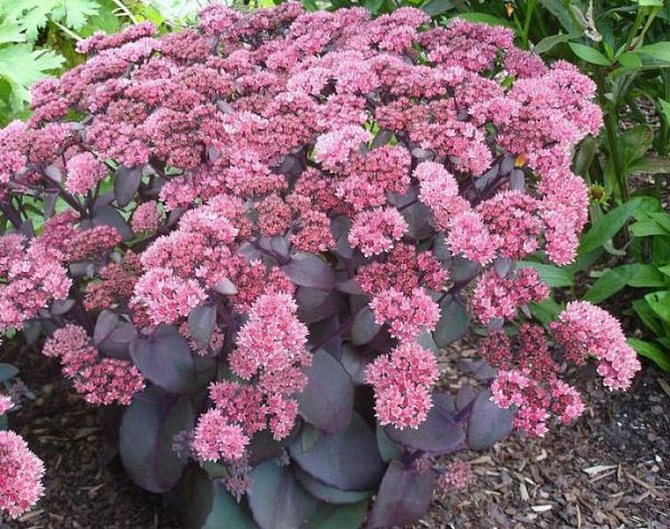

purple emperor
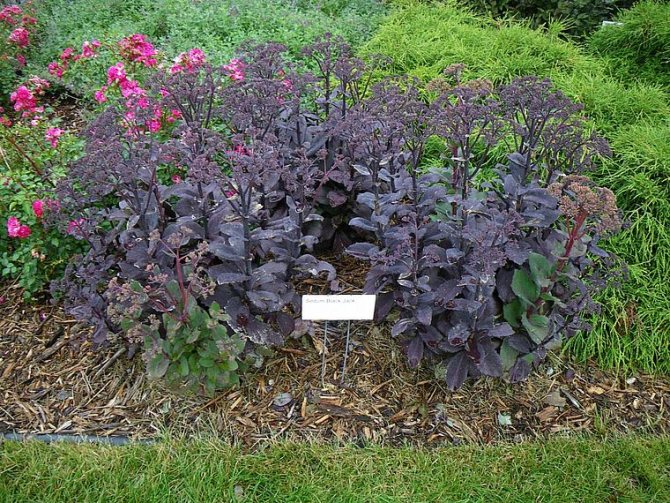

black Jack
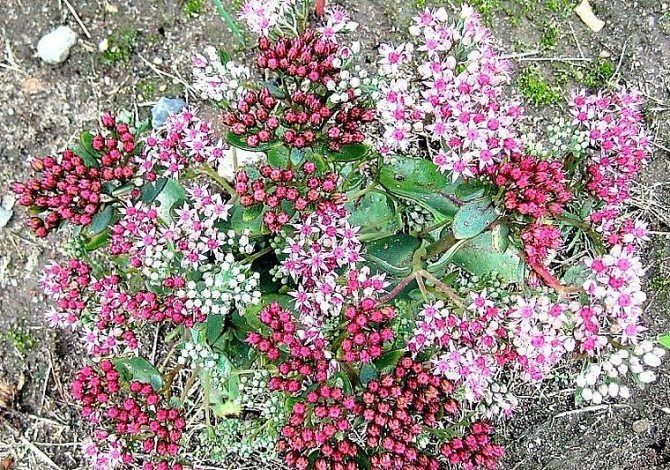

Strawberry and Cream
Beautiful at any time
Sedum will bloom even when the first snow falls. He will change the usual landscape. Pink, crimson, lilac flower petals of various sizes, fabulous coral color, greenish-lemon will dilute the standard autumn palette.


He comes from Asia, in particular, Japan, China, Korea. Autumn looks a little different in these countries. It is partly sedum that contributes to this. An exquisite flower garden, interesting and unusual, can be made with its help. It is actual to grow it:
- in the country;
- in the courtyard;
- on the adjacent territory.
The Slavs have known about sedum for a long time, they began to grow it once, they called it sedum, hare cabbage. However, it is rarely found in someone else's yard, among other flowers of the city flower bed. What's the matter here?
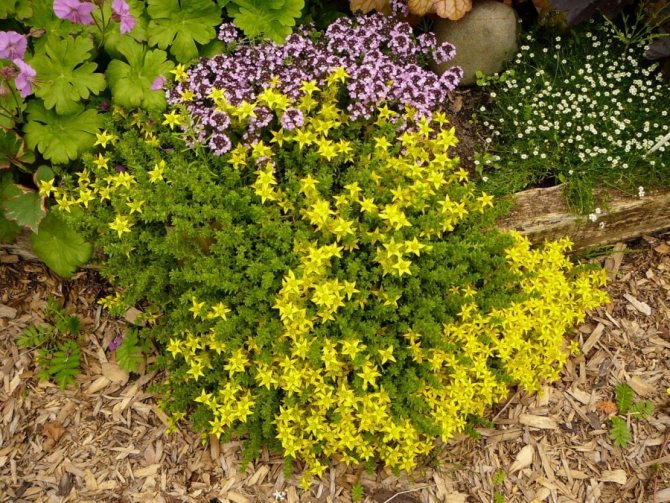

He has a delicate beauty, graceful, fragile. The color scheme may conflict with standard fall colors.This extravagant, extraordinary, bold combination created by nature is a little alarming.
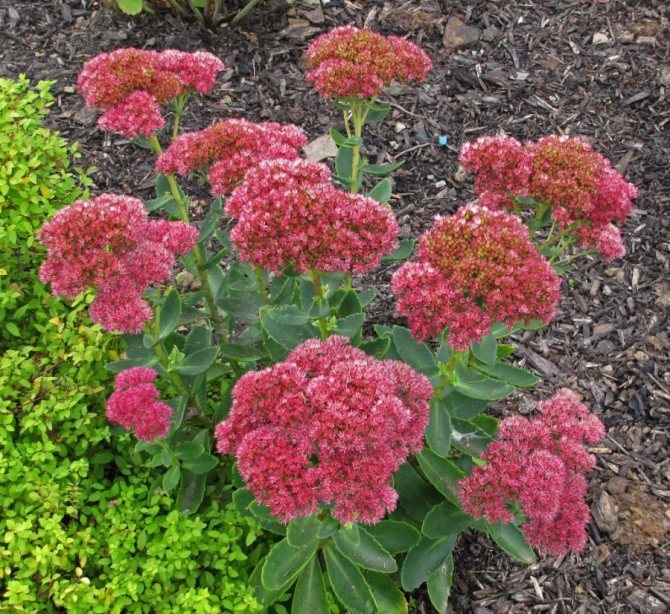

The choice of flowers must be carefully considered. Not every gardener risks working with this crop. If you choose it, the result will exceed expectations. Definitely worth a try, make some space. Soon I will want to buy and grow several more varieties.
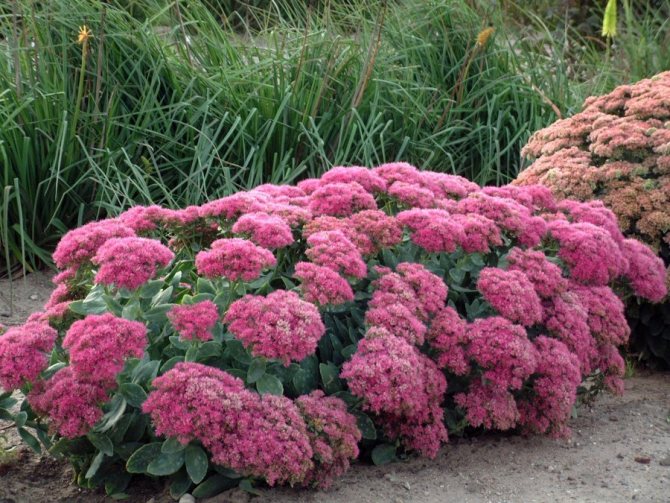

Sedum after flowering
How and when to collect sedum seeds
Sedum grown from seeds, as we have already mentioned, do not retain varietal characteristics. In addition, sedum blooms until the very frost and goes under the snow with green leaves, so collecting its seeds is very difficult. And is it necessary to collect seeds if you can easily propagate stonecrop by cuttings or dividing a bush?
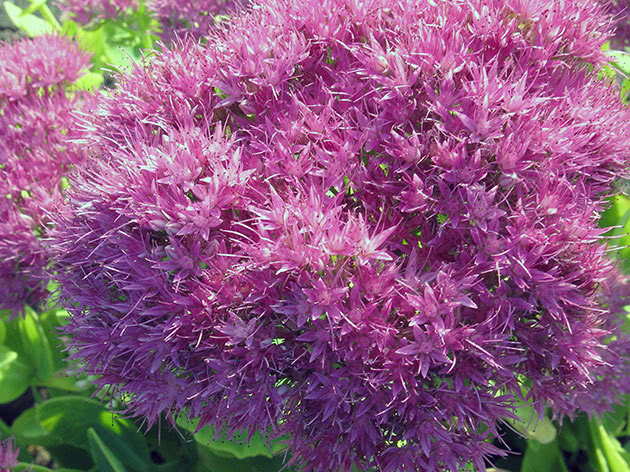

Preparing stonecrop for winter
After the first real frosts, it is better to cut off sedum, leaving only 3-4 cm of shoots above the ground, which must be sprinkled with earth. Cut shoots can be rooted and planted in the garden next year. Some gardeners do not prune sedum - they like the look of sedum powdered with snow. But during the winter sedum will lose its attractiveness, and it will still have to be cut off in the spring.
Landing
Correct and high-quality planting stonecrop is based on step-by-step actions. You should familiarize yourself in more detail not only with the planting process itself, but also with the choice of a seedling and a place.
Sapling selection
The seedling for planting must undergo a thorough inspection. Choose healthy plants. Seedlings with various damages, signs of diseases or the presence of pests are excluded. When examining the leaves, you must make sure that there are no sluggish specimens. Attention should be paid to the soil in which stagnant water and excessive moisture are not allowed. It is also necessary to decide on the variety for the composition, since the varieties differ in the color of the leaves, the length of the shoots and the color of the flowers.
Advice! A low variety is suitable for a flower bed, and a high one for group and single planting.
Seat selection
Sedum belongs to light-loving plants. It is necessary to choose an open, sunny area with good soil, without stagnant moisture. The sun's rays have a beneficial effect on the decorative effect of the leaves. Plant parameters and leaf color are taken into account for a harmonious combination on the ground with other crops. Creeping and ground cover varieties thrive on rocky and rocky areas. Some varieties can also grow in darkened areas, but their stems are significantly extended.
Recommendation! Plants should not be planted under a deciduous tree; in the spring, due to fallen leaves, young shoots may not germinate.
Soil preparation
Unpretentious sedum grows well on various soil. However, for full development and lush flowering, all types of plants require a special composition. All this should be taken into account when choosing a site. Fast growing ground cover varieties require light, loose soil that is rich in nutrients. Other varieties prefer loamy, sandy, or lime-rich soil. Before planting, in any case, it is worth digging up the area, adding a small amount of compost or humus to the soil.
Landing technology
Sedum is planted after a period of spring frost. Time for planting is May. The spacing between plants should be not less than 20-25 cm.
Landing includes the following sequence:
- dig a hole up to 20 cm deep, up to 50 cm in diameter;
- mix sand with humus, in a ratio of 3: 1;
- distribute drainage at the bottom of the pit in one layer;
- fill the pit with the prepared composition;
- make a small depression in the middle of the hole, to the depth of the root system of the seedling;
- carefully insert the seedling into the groove;
- sprinkle with soil, gently pressing down with your hands;
- mark the hole by laying out small stones around the plant;
- put fine gravel or crushed stone in the hole;
- water the seedling.
Attention! Planting a plant in a dark place can lead to depletion of leaves and stems, and in the future it will stop blooming.


Signs and superstitions
Kislitsa brings peace, prosperity to the house, protects the family from quarrels and omissions. The house becomes a full bowl, a meeting place with family and friends.
Kislitsa helps single people find a soul mate, relieves despondency and depression.
In some countries, oxalis is considered a source of joy and material well-being, so the plant is often presented as a gift for Christmas or New Year.
It is believed that anyone who finds a leaf with four cloves at the common sour cherry will always be lucky in everything.
Care
Proper care is the key to not only a healthy appearance of the plant, but also to abundant flowering. Required ingredients: watering, fertilizing and - to a lesser extent - loosening.
Watering
The sedum plant does not like waterlogged soil. In the first period after planting, the plant needs regular, moderate watering. This contributes to its rapid establishment and good adaptation. At a more mature age, watering is carried out during prolonged heat or drought. The guideline for soil dryness is an elementary hand test, if the soil is so dry that it cracked, then it is necessary to water it. If fresh, slightly damp soil is visible when loosening, it is too early to water.
Loosening
Thanks to the process of loosening around the stonecrop, unnecessary weeds are removed and the soil is enriched with oxygen. In addition to loosening, a mulching process is carried out, which keeps the soil loose and enriches it with nutrients. For plants, it is possible to use various mulches.
Top dressing
Special feeding for all types of stonecrop is not required. For the season, it will be sufficient to apply fertilizers only twice: before flowering, and after it. A liquid organic fertilizer is applied using nitrogen in a small amount, until the formation of flowers. At the end of flowering, a complex fertilizer is used.
Advice! Blooming stonecrops in the fall should be cut off the shoots. This contributes to the renewal and rejuvenation of plants.
Photo
More photos of flowers Sedum, see below:
Perfect composition
After looking at the photo of sedum, it is easy to decide whether it is suitable or not. Properties are, of course, also important. The advantage is the unpretentiousness of the plant. It easily takes root, is able to actively develop in difficult conditions, where there are many stones and little soil. Accordingly, with its help, you can create compositions, not only flower beds. It will be easy to take care of them.


The gray color of stones, chaotic spots of granite, the multidimensionality of asphalt paths is appropriate, it turns into a source of harmony. The rocky terrain in the homeland of this plant is not uncommon.
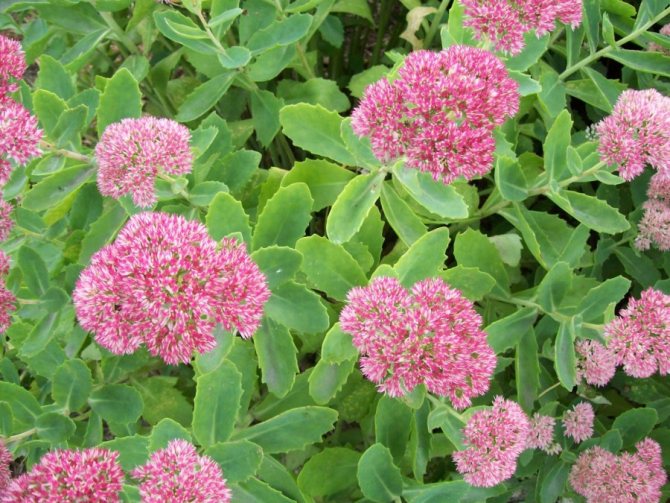

Popular in Japan, China, gardens with a special style, unique solutions, namely, with the inclusion of boulders, focusing on them. Bridges, paths, ponds, fountains are being created. Sedum complements the garden, adds variety.
Japanese garden, Chinese - this is harmony, the ideal ratio of bushes and trees. Green dominates. Shrubs that can bloom are carefully selected. Sedum fits one hundred percent, so they find a place for him most often.
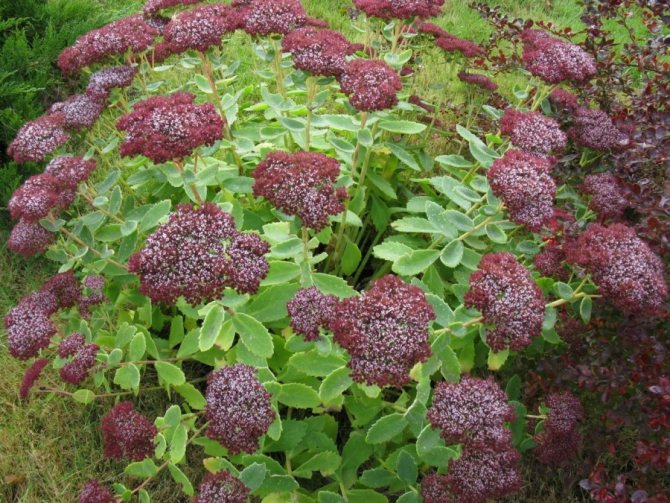

It is not necessary to repeat, copy the techniques of oriental masters, but it is worth taking note. Moss and hare cabbage, aka sedum, is also a wonderful combination. The stone can be placed in the area of the flower bed, not only on the hill. This is a beautiful decoration, the basis for the composition.
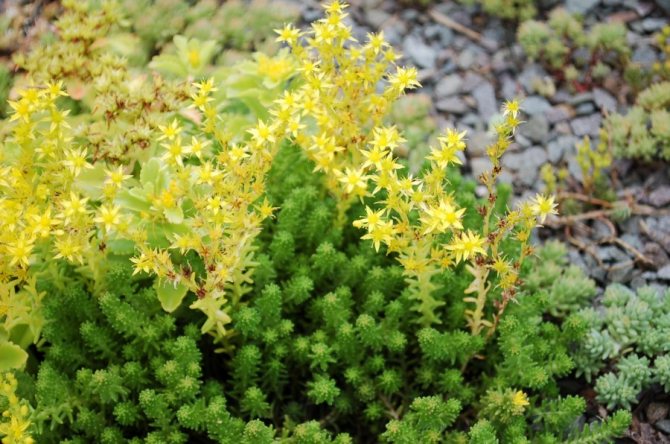

Hare cabbage looks great against such a background - in spring, summer, and autumn. In winter, the foliage, by the way, does not fall off, remains unharmed, because most varieties are characterized by resistance to frost. The landscape will be beautiful all year round.


Sedum is a perennial plant.Having spent one time, taking a little time, caring, you can enjoy the created beauty for a long time.
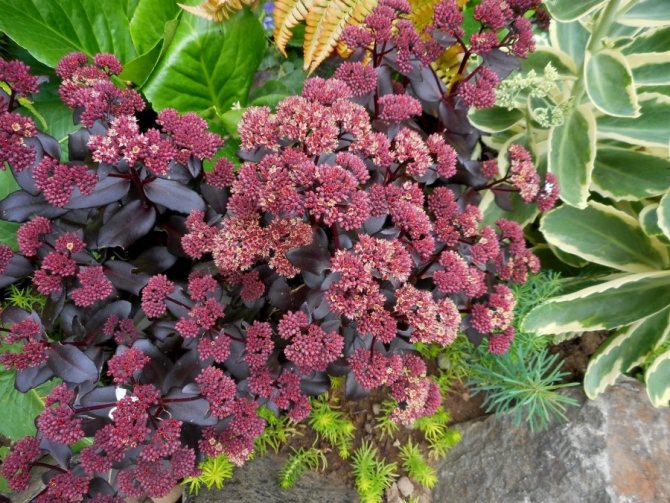

The main task is to choose the best variety, take a closer look, listen to your inner voice, intuition and make a decision. Sedum will give a good mood, take root, get stronger, flourish.
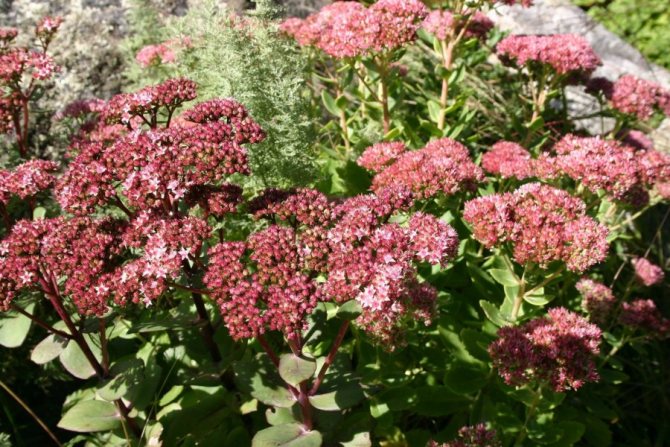

General description
Sedum is an extensive genus. Its representatives may be low shrubs, but more often they are perennial herbaceous succulents. Some species are annual and biennial xerophytes. Often the stems of sedums are long, branching, intertwining with each other and forming dense caps or hanging in long lashes. But there are species that are practically devoid of stems and consist of a basal rosette of succulent leaves.
All sedums have whole, fleshy leaves, most often without petioles and storing moisture reserves. They can be of various shapes - like ordinary leaves with smooth, jagged or wavy edges, like short needles, elongated cylinders, balls or ovals, sometimes they look like arrows or blades. The color of the leaves varies from various shades of green to bluish, cream, purple, pink, red. They are often dyed in two colors or change color depending on the light, temperature or season. The size of the leaves can be tiny, only a few millimeters, or quite large.
Sedums bloom in summer or autumn with small star-shaped flowers of white, pink, yellow or purple color. They are collected in inflorescences, most often spike-shaped or corymbose. In most species, flowering is short-lived.
Planting sedum in open ground
In order to fully appreciate all the advantages of sedum as an ornamental culture, a sunny place is chosen for it.
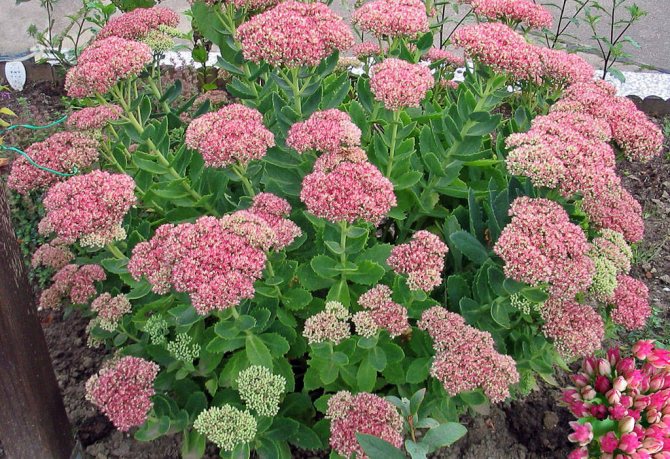

Some sedums can grow in partial shade, but it is in the sun that their fleshy greens of various shades are covered with a pinkish-red "tan", which creates an extraordinary effect.
When choosing a place, one should also take into account the proximity of deciduous shrubs and trees: foliage dropped for the winter will cover the stunted stonecrops with a dense layer, creating an obstacle for them to spring awakening and development.
It will not be possible to free dense, but fragile plants from foliage without the risk of damage, and leaving sedum under the fallen foliage is doomed to death.
So, for sedum, open sunny areas are chosen, where the soil allows moisture to pass through well.
Often, sites are allotted for sedum compositions where no plant will survive because of the stony soil.
Groundcover sedums will transform such an unsightly place and make it the highlight of the garden.
Seedlings are planted after a stable warmth - at the end of May.
The planting holes, if necessary, are first covered with drainage, since sedum does not tolerate stagnant moisture, then - nutritious soil of sand, peat, humus or compost, wood ash.
How to prepare planting material and soil
The best option for planting sedum is in the form of cuttings. The main thing is to properly prepare the soil itself, where the plant will be planted.
The landing site should be bright, but not too humid. This should not be a low place where water accumulates, as everything can rot. As for the soil, it can be sandy, sandy loam, without a lot of clay. Rocky soil is ideal for low-growing varieties.
The flower goes well with low and medium-sized flowers and herbs. It is important that stonecrop bushes on the flowerbed are not shaded by large and tall crops.
Diseases and pests
Sedum is quite resistant to pathogens of various diseases, if not weakened by improper conditions of detention: when the soil is waterlogged, the plant can get sick with rot and spotting.
If the problem is detected at a very early stage, then it is possible to solve it with a fungicide.The diseased plant must be sprayed with a solution of the drug at hand.
But if the affected area is significant, then the diseased specimens are dug up and destroyed: it is easier to replace them with healthy plants, having previously got rid of the causes of the disease.
The juicy fleshy tissues of stonecrops attract pests - aphids, weevils, thrips, caterpillars.
Insects are harvested by hand, plants are sprayed with preparations against insect pests.



